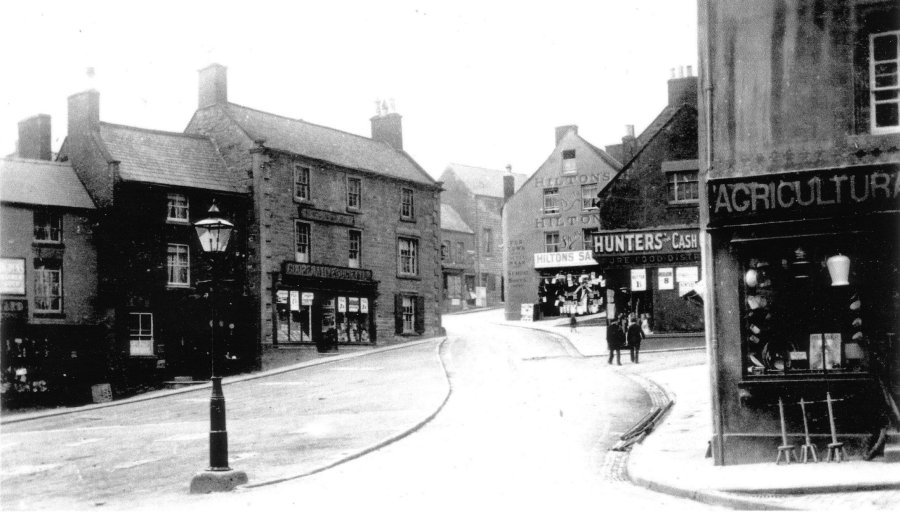- "Shall we start at the West End, the top of the
Market Place. This was the Pig Market and was an area which was cobbled
with stone sets and, on market days and fair days, it was here that
farmers brought their pigs to be sold. Bundles of hay and straw and
wooden palings helped to keep the pigs confined to that area. The noise
and the smell gave a proper farmyard atmosphere."
- "Below that was a long building which stretched across
the top, from The Road (West End) to within 10ft of the doctor's house and
level with his front door. This was, in early days, a milliners'
establishment and here were made the dresses and hats for the "better off"
ladies of Wirksworth. I have been told quite a lot about that because my
mother was apprenticed there and was on staff for some years. Upon the
death of the proprietor, a Mrs. Hall, the premises were turned into a
Conservative Club. I have spent many happy hours as a guest of members.
I could not become a member because our family had a Liberal tradition to
maintain. However, in my youth, I was considered a useful snooker player
(I do hold the record of 52 for Wirksworth snooker), so have played there
in several challenge matches. Supposed to (be) evidence of a mis-spent
youth if you are fine at table games."
- "Below, on the Market side, was
Mr. Millington's shop. A remarkable man -
who could clean and repair any mechanism if he so wished. He was one of
our real characters. Apprenticed in Derby, he cycled down to Sadler Gate
in Derby on Sunday evening to be ready to start with his foreman at
7 o'clock am Monday. At night he slept under the counter in the shop and
returned to Wirksworth on Saturday night after 8pm. Later he worked in
Wirksworth and took over the business when Mr. Evans the proprietor left
to open a shop in Matlock Dale Road. One prospers and one just lives and
enjoys life. Mr. Millington was a keen gardener and an unscrupulous
competitor at the local horticultural shows. So flagrant were his actions
that finally he was (de)barred from all competitions. He also was a keen
rabbit man and always kept ferrets and gun dogs. He had a dog which slept
under his work bench next to the ferret box. His shop was the meeting
place for all the men of his ken. Little work was done, but much libelous
conversation was heard. He was also a great beer drinker. A type of
Wirksworthian we shall never see again."
- "Down again to a tobacconist shop kept by a
Mrs. Pickard, who was stone deaf. It was
considered a joke to slip into her shop, quietly whilst she was arranging
her stock of cigarettes, and suddenly yell, causing confusion etc. She
was so deaf that she was unable to say if this had been done on purpose -
that is, if you kept your face straight. Otherwise you were reprimanded,
then reported - that meant a good hiding. All considered in a day's march.
Below again was the house with the door opening onto the market."
- "We are now down to within 10ft of the Hope and Anchor. This area has
also changed. Where now is the dining room of the Hope and Anchor was a
shop. I remember it as
Palin's, the green-grocer, in my early days -
later they moved across the Market. But, for many years after that, it was
a baker's shop kept by a
Mr. Brough. His bake house was across the
narrow Causeway as shown on the map. Mr. Brough's son was Charlie who
you knew so well. Imagine the smell of hot new bread which came from out
of the bakehouse. One could stand outside and see the loaves, cakes and
buns being taken from the oven. He also baked meats and made Cornish
Pasties and sausage rolls."
- "Next door again was the
Miss Greatorex's establishment, who sold home
made sweets and everlasting sticks and liquorice bootlaces. For 1d one
could have a night's enjoyment from Miss Greatorex. The shop had a paned
bow window and it was one step down to the counter. This corner I now can
see was a typical Dickensian corner, also all gone."
- "Opposite was, as shown, two cottages. These cottages and the bakehouse
formed the base of an isosceles triangle of buildings. Across from the
cottages was a curio shop kept by a
Mr. Millward. His shop was a curious jumble
of bric-a-bat. I never knew if he sold anything. I remember he had gold
rimmed glasses on the end of his nose and he took snuff. This, we were
informed, was a "dirty habit" and he was looked on with suspicion.
- "So there we have one side of the Market which has now all disappeared.
It was demolished in one of Wirksworth's great upheavals, but quite
recently, perhaps 1930. As that needs recording, perhaps that might need
a special paragraph later."
- "Up to the other side of the "Market Place No 1". Structurally, this
side is almost the same, although the uses to which the premises have
been put have altered."
The Building Society's place was Hilton's Boots Shop
(kept by Mr. Pattin)."
- "Then the Black's Head (as now)."
- "Below was the London Central Meat Shop"
- "and then Hunter's shop.
These two are now combined into the Laundromat. Palin's shop was the
Crown Inn, a very old establishment with extensive stabling in the rear.
- "Then Bradley's and so down to
- "Marsden's at Scotts
Corner, so called because years ago a cripple called Scott used to sit at
the corner for many years."
|
